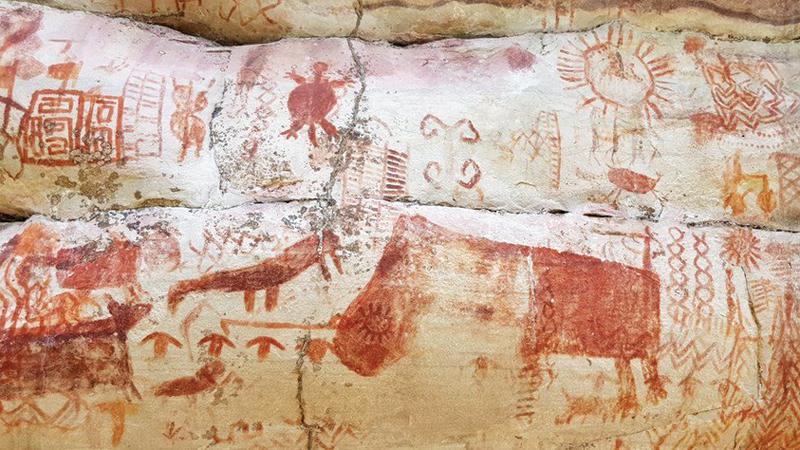
The Amazon forest is the world’s largest tropical rainforest spread over nine countries including Colombia, Brazil, Ecuador, Bolivia, Peru, and Venezuela. A large number of primitive tribes have been living there for centuries.
There had been no extensive archaeological excavation of prehistoric human settlements in the Amazon, and information revealed by such an excavation and exploration in Colombia was recently reported. According to it, modern humans have been living in this region since 13,000 years ago.
Serrania La Lindosa is a forest area located in the northwestern Amazon rainforest in the central region of Colombia. It is also considered to be a forest region with the highest biodiversity in the world.
Marxist guerrilla groups
Primitive tribal populations still live in this tropical rain forest region which has now been named as the largest national park in Colombia. Colombian Marxist guerrilla groups held power in most parts of the region from the 1960s until 2016.
Due to the guerilla rule, there were barriers for researchers to enter the region, but in the 1990s, a group of researchers engaged in limited research in this region. Based on it, they started research again from 2017. According to the information found there, the first settlements in the Amazon forest were established in the Serrania la Lindosa area. Evidence of pre-human settlements as well as drawings on granites created by them, spread over a large area, have also been found. They have been well protected so far without any destruction.
 The Amazon forest region was the least used for research on human settlement in the United States. Recently, many researchers have been interested in investigating the early human settlements in this region. Pre-human paintings have been found at two places here. The first place is Serra Azul, also known as the Blue Mountains. Excavation work was carried out there in 2014-2015 and 2017-2018. According to the excavations, it was revealed that humans have lived there from 8000 to 12,200 years ago.
The Amazon forest region was the least used for research on human settlement in the United States. Recently, many researchers have been interested in investigating the early human settlements in this region. Pre-human paintings have been found at two places here. The first place is Serra Azul, also known as the Blue Mountains. Excavation work was carried out there in 2014-2015 and 2017-2018. According to the excavations, it was revealed that humans have lived there from 8000 to 12,200 years ago.
It was possible to reveal the first Homo sapiens human settlements in the South American continent. It seems that the stone age man who came in this way faced the transitional period from the Pleistocene ice age to the Holocene era that we live in today. Several research groups, including researchers led by Gaspar Mokote Rios of the National University of Colombia had joined the excavation work there.
In the lowest layers of the cave excavations, parts of the stones used by them to create paintings have also been found.
Primitive paintings
A large number of primitive paintings drawn by prehistoric humans when they had free time were found in the caves that stretch for eight miles through the forest in this section. These contain tens of thousands of different images.
Archaeologists and anthropologists were surprised by this discovery. It is believed that the first humans who made the Amazon forest their home may have painted these caves. It seems that those humans represent the Middle Stone Age
These pictures depict many species of animals that lived in the Amazon forest during the Pleistocene or Great Ice Age of Earth’s geological history. Today, among them, many species of animals have become extinct. Because of this, anthropologists say that these drawings can be used to study ancient animals.
Since the drawings are from the bottom to the top of the granite walls, it is thought that ladders or wooden pillars have been used to draw them. Now the Colombian Government has decided to designate an archaeological park with 60 archaeological sites to protect this area and attract tourist attention.
The harsh weather conditions of the Pleistocene period created difficulties for both humans and animals living in that period. At this time, the Holocene era was beginning, saying goodbye to the last ice age. It happened more than 12,000 years ago. Archeological excavations conducted in Serranía La Lindosa have revealed information about how prehistoric humans faced the environmental conditions of that time. The thousands of drawings drawn on the granite walls have also been used to clarify that fact.
It has been observed that geometrical shapes, human figures, handwritings, notes of thousands of plants and animals have been drawn in the cave complex in the mountain rocks which are spread for miles along the forest.
Cave covers
These have been photographed and filmed for television documentaries. Excavations have also found many archetypes of humans who used those cave covers to live. They have been dated to 12,000 years ago. Such paintings are painted on smooth, flat granite walls. For thousands of years, they have been well protected even because they were drawn in places with cave covers that did not get wet from the heavy rains.
Recognisable animal figures in the paintings include deer, crocodiles, bats, monkeys, tortoises, snakes, and wasps, among others. In addition to these animals, the animal species that lived in the Ice Age can also be seen in these paintings. It increases the value of these paintings. Apart from this, hand marks, geometric designs, hunting occasions and manners are also depicted here.
Extinct animals include giant sloths, camels, horses, and the three-hooved Xenorhinotherium. There is also a species of horse that lived in the Ice Age in American art with a large head.
Among the paintings of these animals, human figures are very small.
